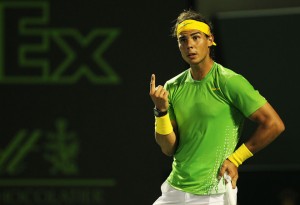KEY BISCAYNE, Fla. — Roger Federer and Rafael Nadal will meet for the first time in North America in six years Friday in the semifinals of the Sony Ericsson Open. Ironically, the previous two North American meetings between the two tennis titans have come on the courts at the Tennis Center at Crandon Park in this island paradise in the shadow of the Miami skyline.

In the first career meeting between the two, Nadal, then 17-years-old, defeated Federer in the Round of 32 in Miami 6-3, 6-3, while Federer turned the tide the following year in the final, coming back from two-sets-to-love down to win 2-6, 6-7 (4), 7-6 (5), 6-3, 6-1 back when this event boasted a best-of-five final.
Rene Stauffer, the esteemed Swiss tennis writer and author of the book ROGER FEDERER: QUEST FOR PERFECTION ($19.95, New Chapter Press, www.RogerFedererBook.com), details the previous two Roger vs. Rafa clashes in North America here at the Sony Ericsson Open in his book. Below are the excerpts detailing the first two matches of this epic rivalry.
2004
An opponent that would bring Federer to his knees, however, appeared shortly after Indian Wells—illness. Immediately after the final, Federer began to run a fever and suffer from nausea and muscle pains. Despite his illness, he did not cancel his pre-arranged trip to Portland, Ore., the home of his clothing sponsor “Nike,” for a promotional visit, but en route to Miami for the next tournament, Federer was forced to stop and check into an airport hotel in Los Angeles to rest and try to recover. As he and Mirka finally arrived in Florida, he considered withdrawing from the tournament, but when rain gave him an extra day of rest, he decided to give it a go.
After he was able to muster up enough strength to negotiate a three-set win in his first match against No. 54-ranked Nikolay Davydenko of Russia, Federer next drew the highly-regarded Spaniard Rafael Nadal. The 17-year-old left-hander from Mallorca played what he described at the time as the best match of his life and dominated the listless Federer 6-3, 6-3. The loss was the most decisive defeat Federer experienced in a year. Nadal also became the youngest player to defeat the Wimbledon champion. Federer was not surprised that he lost since he was not yet recovered from his illness.
Nonetheless, he suspected that Nadal would be a dangerous rival coming of age. “He will become the most powerful left-hander in tennis in the coming years,” Federer prophesized.
2005
After defeating world No. 2 Lleyton Hewitt in the final of Indian Wells, Federer won the title in Key Biscayne, Fla., for the first time, defeating the young 18-year-old Spaniard Rafael Nadal, who defeated Federer decisively at the same event the previous year.
Entering Key Biscayne, Nadal moved to No. 6 in the year-to-date ATP Champions Race with victories in tournaments in Brazil’s Costa do Sauipe and in Acapulco in Mexico. His match winning streak hit 15 as he entered the Key Biscayne final with Federer. The burly left-hander played fearlessly in his first appearance on the big stage of professional tennis and to everyone’s amazement, he led Federer 6-2, 7-6, 4-1 after two hours of play. “I looked up at the scoreboard and only hoped that 6-1 would not appear there ten minutes later,” Federer explained. “I blew one opportunity after another and I thought, ‘This can’t be happening.’” In an earlier time in such a situation, Federer would have thrown in the towel but these days were well in his past. Somehow, he crawled back into the match and, came back from a two-sets-to-love deficit to win 2-6, 6-7 (4), 7-6 (5), 6-3, 6-1.
The Indian Wells/Key Biscayne “double” that went favorably for such players as Jim Courier, Michael Chang, Pete Sampras, Marcelo Rios and Andre Agassi before him, now garnered Federer 1,000 points in the world rankings, the equivalent of a Grand Slam title. He was now 2,245 points ahead of Hewitt in the No. 2 spot. The conversations that Federer may be in a “crisis” quickly faded. “This is a great moment in my career,” Federer said after his win over Nadal. “Making a two-set comeback against a player of his caliber and then winning it isn’t normal—even for me.”
